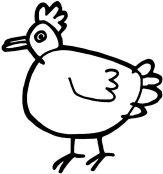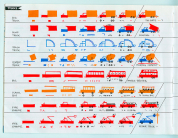 If I asked you to draw a picture of a chicken what would your reaction be? “No way, I can’t draw” or “Sure, no problem!”?
If I asked you to draw a picture of a chicken what would your reaction be? “No way, I can’t draw” or “Sure, no problem!”?
Many people I work with have a black and white view when it comes to drawing. They think they either can or can’t draw.
For this reason, teaching any form of visual note-taking to students, such as mind mapping, is often accompanied with loud groans and much resistance.
“My teacher already taught me this”, “Oh no, anything but mind mapping!” and “I can’t draw for *#$%!” they say with distressed looks on their faces.
What students often fail to realise is this – you don’t need to be good at drawing to take visual notes. All you can manage are stick figures? Stress less. This is actually a great place to start.
Here’s the thing: any picture is better than no picture when it comes to taking notes. Why? Well, research demonstrates that students that draw pictures when they learn retain 30% more information than students that don’t draw pictures.
So you can relax. Your pictures don’t need to be perfect. As long as you can understand them that’s all that matters.
Which means that even simple, rough pictures are fine. But if you’re not satisfied with your stick figures, the good news is you can improve your drawings and it doesn’t have to take you years of hard work and practice.
Don’t get me wrong, practice can make you really good at pretty much anything (drawing included). Take my friend Sharon for example. She’s been drawing since the age of 3 and slogged away at art school and as a children’s illustrator for many years. Now, she whips out fun, little drawings at amazing speeds with ease whilst watching television. She regularly reminds me –
“The more you draw, the better you’ll get”.
But let’s say you want to improve your drawing skills and don’t have years to devote to this activity like my friend Sharon did. How can you fast track your drawing skills and take them to the next level?
There are some amazing resources out there that show you how to draw the basics and the basics are all you really need if your taking visual notes for subjects like law, psychology, environmental science or history.
So if you’re keen to progress from drawing stick figures, I highly recommend exploring the following useful resources –
 Make a world by Ed Emberley: This classic book shows you how to draw almost anything in a number of simple steps. Ed Emberley states that if you can draw some basic shapes (e.g. a triangle, circle and square) then you have what it takes to draw all the pictures in his book (and there are dozens) – horses jumping, Vikings, pirate flags, camels, etc.
Make a world by Ed Emberley: This classic book shows you how to draw almost anything in a number of simple steps. Ed Emberley states that if you can draw some basic shapes (e.g. a triangle, circle and square) then you have what it takes to draw all the pictures in his book (and there are dozens) – horses jumping, Vikings, pirate flags, camels, etc.
Austin Kleon’s Blog: Austin Kleon is a poet with a difference (he takes newspaper articles and blacks out the words he doesn’t want with a thick black marker to create his poems). He’s also an awesome visual note taker to boot. He has taken visual notes for conferences and written several blog posts on visual note-taking. Check out a collection of his blog posts on this topic here.
Visual Note Taking 101: A group of visual note-taking gurus (Austin Kleon, Mike Rohde, Sunni Brown and Dave Gray) spoke at a conference on the basics of visual note-taking. The audio was recorded, synced with the slides they used on the day and uploaded online. Whilst it’s a bit slow to get into and a fair bit is lost by not being able to see these people speak, there is gold in this 58 minute session. It’s well worth seeing samples of their visual notes and hearing their tips.
Whether it was a teacher or a school student that told you couldn’t draw, you shouldn’t let those conversations stop you from taking visual notes in your classes. It’s actually a lot of fun. And what we know from the psychology of learning is that:
Fun = Greater understanding + retention of information = Better grades

2 thoughts on “Visual note-taking for people who think they can’t draw”
i love mindmapping and learning with visual help. but mindmapping is not possible when you have to study for courses with only abstract contents like “consciousness”, “naturalism”, “states”, “induction vs deduction” and “psychometry” and thousands more of these.
there seems to be no other way around it than hardcore learning by heart, which i absolutely detest. =(
Comments are closed.